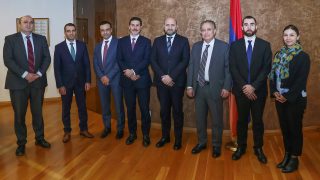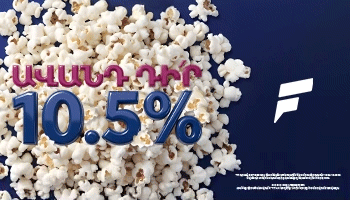
Cattle breeding failed: most cows imported by government project died

Seven years ago the government of Armenia announced a project for developing cattle breeding in 2007-2015. The government decided to import different types of cattle from Europe and give to farmers and villagers on credit (for 4 years – 10% interest rate applicable the first year, 20% – second, 30% -third, and 40% for the fourth year).
In that interval the number of cattle in Armenia did not grow but slumped by 7,333. According to official information, as of December 31, 2007, there were 310,610 cows in Armenia, and as December 31, 2012 – 303,277 cows.
168 Hours contacted the media department of the agriculture ministry and asked about the results of the project. In answer to our request we have received a letter signed by Ashot Hovhannisyan, head of the cattle breeding and health department of agriculture ministry. The letter writes, “Since 2007, in the framework of the cattle breeding development project Armenia has imported cattle amounting 1,811. By the end of the year we are planning to import more 450 ones, and during the coming years – more 300.”
However, there are only 1,778 cows in the list for distribution of cattle to farmers. The official’s letter does not say where the other 33 cows are. Cows have been distributed between more than 50 farms.
Normally due to this project the number of cattle should have gone up, at least by one annually for every cow provided. According to our information, most cows died months after being brought to Armenia, and farmers had to fully pay against the amount required (the price of one cow is about 1 million drams).
In answer to our question whether the cows could adapt to the conditions in Armenia and whether there were cases of losing cows the official letter writes, “There is no problem with adaptation of animals as all three types of cattle have been imported and kept in Armenia since the Soviet Time.” The ministry does not refute the information of losing animals but brings explanations saying that some of them died because of sicknesses.
Research shows that annual success rate of cattle breeding in Armenia is below 10%, while in Russia, Azerbaijan, Georgia and Ukraine it is 30-40%.
According to our information, before long transportation trips animals are subject to specific medicine shots to refrain from stress so that they do not feel the distance and transportation. Such research and information has been published, for example, by Cattle Breeding in Russia journal in 2009. Pregnant animals have to travel 7 days from Holland or Germany to be transported to Burgas, then they are loaded on a ferry to be transported to Poti port in Georgia, where they are loaded on trucks again to be transported to Armenia. During transportation animals must be free of ropes to have a rest every 24 hours. In Europe transporters follow this procedure as they have special areas for that purpose. In Poti and on the way to Armenia, however, this procedure is not followed and animals have to be tied still during 4-5 days. Failure to have a rest on the way results in stress and loss.
For research purposes we have visited a number of project beneficiaries. There are many enterprises linked to state officials among the project beneficiaries. During the first year of the project Multi Agro, a popular company in Armenia, purchased 21 cows. The company’s general director Roza Tsarukyan says that the next day the cows were delivered 1 of them died, and the compromised 50% of the fee. In three days after delivery another cow died, and other 7 died during the same year. The remaining cows died next year.
“Nineteen cows were starving and became slim. Medical checkup showed that they had blood pressure problems. We took them up to the mountains in 14 kilometers, and as they felt sick there too, we brought them back,” said Roza Tsarukyan and added that veterinarians invited from abroad were not able to diagnose the problem.
Even though the animals died, the ministry of agriculture made all companies pay (including Multi Agro). The general prosecutor’s office interfered and made all farms pay according to a court verdict brought up for that purpose.
“From the very beginning I objected to that project. Those animals did not adapt to or climate. I have paid 24 million drams. I did not want to give some of that money as the finance ministry still owes us 15 million drams for pigs that died the other year. They still owe that money, and as they threatened they’d institute legal proceedings, I decided to pay,” said R. Tsarukyan. She also said that two years before the ministry of agriculture had tried to implement a similar project with sheep, but after her objection they gave up.
Arzni CJSC is in similar situation. Since 2007 the company participated in the project four times and purchased 359 cows. Armen Janvelyan, director of Arzni CJSC says that in 2008-2009 they purchased other 61 cows with cash payment. However, in 2008 they lost 38, in 2009 – 30, in 2010 – 47, in 2011 – 82, in 2012 – 67, and in 2013 – 25 cows (totally 289 cows). Thirty out of this number died because of being hit by electricity, and the others died because of the difficulties during transportation and failure to adapt to the local climate.
“Imported animals have a problem of adapting to the local climate. We learnt to breed cattle due to our experience with loss as nobody taught us how we should take care of them. After bringing those animals we learnt about certain types of sicknesses for the first time. In 2010 we received 33 cows from Germany, and during the first 6 months 90% of them died, and we could not understand why. Veterinarians arrived from Holland and the ministry of agriculture of Armenia, took tests but they could not say what the problem was. The animals simply did not eat anything,” said A. Janvelyan.
By the way, according to him, the ministry of agriculture has asked to show smaller amounts of death among the imported cattle. “I would not get into that project, which was planned without taking into consideration potential risks. They calculated everything with ideal outcome, which is impossible in normal farms. I have spent one million dollars. Till 2010 I was paying for the cows with the money generated from poultry but later I started having problems with poultry, too. Cattle breeding is not profitable. If I slaughter what I have and sell as meat, I may be able to pay off. However, if the goal is creation of better farms, it is impossible to achieve in 4 years.”
According to agreement between the ministry and company, all outstanding debt not paid in time is subject to 0.05% penalty for every day of delay. In May the company had to pay 359,327k drams, 332,32k being the amount of debt, and 27,295k – as penalty for delay. The company has already paid 359,80k drams (27.2 million as penalty and the remaining was paid for debt coverage). Penalties are significantly increasing the amounts to be paid.
Mr. Janvelyan has sent written requests to the government asking t help with the problem but the letters were forwarded to the ministry of agriculture. In April, Grisha Baghiyan answered the letter writing that the terms and conditions of the agreement could not be changed and the company had to pay according to it, including penalties were applicable in case of delay. It is worth mentioning that in his e-mail Mr. Baghiyan introduces the ministry as defender of farmers’ interests, and the government- as an institution that rips off. “Meanwhile I would like to inform that the ministry submitted a letter (SK/AA-2/3582-13), dated July 4th, 2013, to the RA government with a petition to reconsider the terms and conditions for calculating overdue amounts against cattle provided by the ministry of agriculture to farmers and debts resulted from it. In answer, on July 22nd the government instructed to take measures to collect all debts in full,” writes the letter of the agriculture ministry officials.
A.Janvelyan says he has even suggested the ministry to sell the cattle his farm has bought to others with 30-40% discount to reduce his debt, however, this petition was refused, too. Meanwhile, Janvelyan says that he was even ready to offer local cattle that are adapted to the climate and produce more milk.
The question is why the ministry is not interested in including local cattle in the project. This would save them money and risks. Are ministry officials more interested in travelling to Europe with the government money? Maybe they are interested in 100 Euro kickback, which, according to our information, they receive for every cow they commit to buy Europe
To be continued
By Gayane Khachatryan
P.S. If in the first years of the project beneficiaries were large farms, now beneficiaries are small farms. It will be impossible to continue the project during the next years as there will be no more buyers. Notwithstanding this failure the ministry has developed another project aimed at development of cattle breeding in 2013-2020, and the cost of this project is going to be 500 million dollars.























